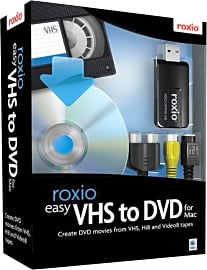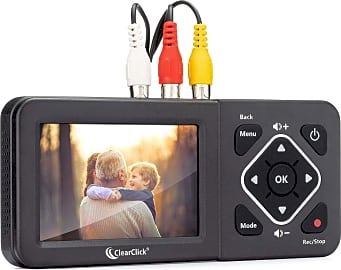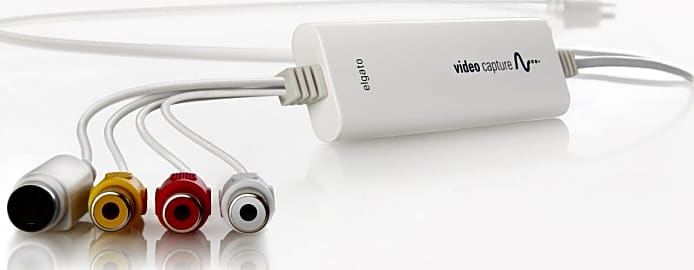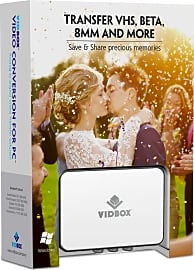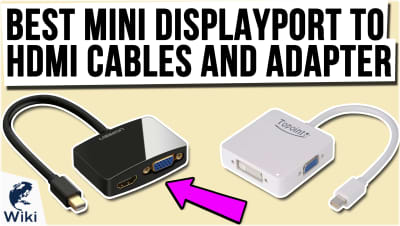The 9 Best VHS To DVD Converters

This wiki has been updated 36 times since it was first published in May of 2016. If you have a box full of old home videos taking up space and getting dusty in the attic, you should consider bringing those memories up to date with one of these VHS to DVD converters. Many of the items on our list will not only let you burn the footage to disc, but also convert it to digital files that are ideal for uploading to Facebook or YouTube. Note that you need a working VCR for some. When users buy our independently chosen editorial recommendations, we may earn commissions to help fund the Wiki.
Editor's Notes
November 13, 2020:
These days the most common solution for transferring VHS videos to playable DVDs is picking up a software package that's bundled with a USB capture card. This would include options like Elgato Video Capture, Vidbox Video Conversion Suite, or the more affordable Roxio Easy VHS to DVD for Mac. These choices all focus first and foremost on ease of use, which definitely makes them a great selection for people who simply want a quick way to share their old home movies with family and friends. However, their simplicity may also be detrimental for those who are trying to create an archival-quality result. These options all produce highly compressed digital video files that are small and easy to send over the internet, but users who are looking to make the highest-quality recording they can may be better off with third-party or open-source solutions. This route allows you to create as high- or low-quality files as you desire, and gives you the opportunity to fiddle with different deinterlacing algorithms, bitrates, and all sorts of other settings that simplified proprietary programs usually don't provide. If you decide to pursue this method, the good news is that you can pick up a super affordable adapter such as the If-Link Capture Card. In fact, if you are interested in open-source software it's best you avoid proprietary bundles, since the adapters they come with are usually locked to the program they're packaged with.
If you're converting a lot of VHS to DVD you may be better off with a dedicated piece of technology like the Toshiba DR430 or Sony VRDMC6. These purpose-built DVD recorders offer several benefits over their PC-based counterparts, not the least of which is leaving your computer unoccupied during hours-long recording sessions. Whereas with a software solution you would first capture the video and then separately burn it to a DVD these devices begin transferring an incoming video signal to a blank disc the moment you hit record, thereby saving you some extra steps and often avoiding the harsh compression that is applied by many programs. However, it should be noted that this also makes them less ideal if your intention is to share the videos online, as you would have to rip your DVDs in order to do so. Those who would prefer this method but are unable to find a VCR may be interested in the Funai Combination Recorder, which combines a VCR and a DVD recorder into one device.
Still, the easiest option of all is letting someone else do the work. Though it doesn't provide you with the same level of customization, sending your tapes to a company like Lotus Media Digitization Service or Time To Remember Transfer may be both the simplest and most affordable option if you're only dealing with a few tapes. Those who would like to avoid doing their own DVD burning should be aware that Lotus Media Digitization Service is the only one of these two that will undertake that process for you.
November 28, 2019:
There are a few different routes you can take when you want to preserve your VHS video to save space and make them last quite a bit longer. The simplest DIY options are the DigitNow Capture Tool and the Elgato Video Capture, which plug into your VCR and your PC's USB 2.0 slot -- don't use a USB 3.0 port or it might produce some static or video noise. The Vidbox Video Conversion Suite is a purpose-designed system that works well and comes with all the software and hardware needed, although it's a bit limiting if you ever decide you want to use alternate software, because it's just not compatible. If you already have all the adapters you need, consider Nero Platinum, which is one of the most well-known burning applications and lets you do a wide range of things to your media aside from simply archiving it.
If you find yourself performing this task quite frequently, check out the ClearClick Video To Digital. It's a standalone device that works without the need for a PC at all, so it's great for digitizing video on the spot when there might not be a capable computer handy. And if you don't have a VCR yet, the Funai Combination Recorder can help, as it's one of the few readily available models with an integrated DVD burner.
Then there are some highly convenient services that are worth a look if you want good-looking video but don't want to go through the hassle on your own. Time To Remember Transfer provides you with MP4 files and Lotus Media Digitization Service offers you the choice of an actual DVD, and they're both relatively affordable and will get you results in very little time. We've also listed some professional services in the Special Honors section if you'd rather go with a more well-known company.
Special Honors
Kodak Digitizing Service Industry giant Kodak provides a mail-in service that's hard to beat in terms of quality and professionality. Simply tell them how many VHS cassettes you need converted and they'll send you a crush-proof box to mail them in with, and they'll do the rest, resulting in a secure thumbdrive, online download, and watchable DVD set for your viewing pleasure. kodakdigitizing.com
Costco DVD Transfer One of the most convenient parts of the retail provider's service is that you can drop your tapes off at any of their many locations and receive your results in just a few days. As with many of their offerings, it's considerably less expensive than many other professional options. costcodvd.com
A History Of The Vaunted VHS Format
The first VHS players and tapes readily available to the consumer marketplace came out in Japan in 1976, and in the United States in 1977.
The VHS cassette tape was first developed by JVC, a Japanese technology and electronics company, in the 1970s. VHS is an acronym for the Video Home System, and indeed that descriptive name is an apt one for these units. Understanding why merits a look slightly farther back into history.
Magnetic tape was first used for audio recording, with viable application seen in the late 1920s. Magnetic video recording tape was first developed some two and a half decades later. In the 1950s, magnetic video tape was commonly used in the professional television industry, recording shows for later rebroadcast. The complexity and expense both of early video magnetic tape and the machinery that processed it limited the use of the medium to professional media production and broadcast companies and to certain medical and scientific applications, such as with fluoroscopy imaging.
Flash forward another two decades to the 1970s, and we see the beginnings of what would be the first commercially viable home video platform. And indeed beginnings is the right word, as two competing formats of magnetic video tape came to the fore during that decade. One, produced by the Sony Corporation, would come to be known as Betamax, a video tape format that actually went on to see extreme success in various professional fields, and limited success as a format for home movie watching.
It was the Video Home System -- the iconic VHS video cassette -- that would soon be lining the shelves at video rental stores and tucked into cabinets and drawers in homes all around the world. The first functional VHS tape prototype was produced in the year 1973, after several years of development. The first VHS players and tapes readily available to the consumer marketplace came out in Japan in 1976, and in the United States in 1977. Despite entering the market more than two years after the release of the comparable (and arguably superior) Betamax format, VHS tapes soon became the ascendant platform thanks to a furious marketing effort and thanks to agreements between JVC and various other companies that saw the format used by multiple multinational companies.
VHS recorders/players, also known as VCRs, were a mainstay of living rooms, classrooms, offices, and beyond for more than twenty years, but the latter half of the 1990s saw DVDs begin to chip away at the platform's marketshare (in a way that laser discs and other video options certainly never had). Improved digital technology would sound the death knell of this fine analog format, though in fact VCRs were still being made right up until the year 2016, a testament to the lasting quality of the format and hardware, as well as to the power of nostalgia (and/or inertia) among many media consumers.
Why Converting Tape To Digital Is Essential
Venerable and celebrated though the VHS format may be, it is also vulnerable, too. Time is the greatest enemy of the Video Home System video cassette tape, with quality degradation slowly but steadily reducing the functionality of the tape, and with repeated viewings only speeding up the process. Video cassette tapes often deteriorate past the point of viable playability due to demagnetization, a process which can happen over time or that can occur rapidly in the event that a powerful magnet or a potent heat source comes into close proximity with the tape. A demagnetized tape has lost the ability to transfer the images and audio it once held to a video tape player.
The VHS format was all but doomed in the era of binge watching television and marathon viewing of movie series, its inherent degradation notwithstanding.
Other factors that can speed the deterioration of a video cassette tape are humidity and/or direct contact with moisture or liquid. When a VHS tape is stored in humid conditions, or else when a fluid is spilled or splashed onto the cassette, it can cause the tape to become distorted, sticky, or otherwise compromised, leaving the very real potential that the stresses put on the tape by its next viewing will cause it to break completely or become distorted beyond viable use.
According to a survey of research conducted by various groups, including the Jet Propulsion Laboratory in Southern California and the Sony and Fuji corporations of Japan, even video cassette tapes stored under ideal conditions will deteriorate by an average of 15% of quality every 15 years, so eventually all tapes will be broken down beyond use or repair.
And then there is another factor to consider: the VHS cassette tape format, using its thinnest (and weakest) tape could allow for, at the very longest, less than five hours of playing time. A modern Blu-ray disc (and even many DVDs) can hold significantly more material, with a Blu-ray disc capable of storing nine hours of high definition content, and as many as 23 hours of standard definition media. The VHS format was all but doomed in the era of binge watching television and marathon viewing of movie series, its inherent degradation notwithstanding.
Choosing The Right VHS To DVD Converter
There are two basic approaches to converting VHS content to DVD content. The first, and the easiest, involves using a deck that has both a VHS slot and a DVD drive with burner capabilities. The use of these machines is plug-and-play simple, and perfect for those who want to preserve their media before it deteriorates but lack much technological prowess.
Second, there is the option to use a device that features older RCA inputs paired with an advanced USB or HDMI output. You will need to own a VCR to play your old tapes to make use of this approach, and you will need a bit of software and hardware knowhow to select the right program to record the media you are playing via that charming but outdated VHS tape.
The benefit with the latter approach is their potential for use with other mediums, such as for recording gameplay you wish to upload to social media or share with friends later.




